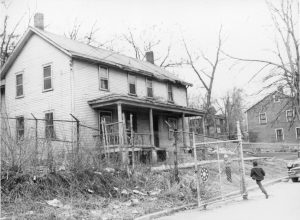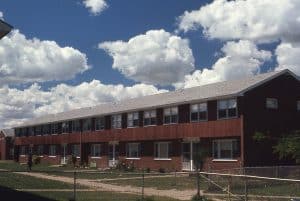From Pre-Emption Park to Courtyard Apartments
By Becky Chapin, Archivist
On November 9, 2023, Historic Geneva hosted a Community Conversation on Race and Housing at the Adams Intercultural Center at HWS Colleges. We viewed a short film called “Home: Access Denied” about the history and legacy of residential segregation in Greater Rochester. Webster teacher Greg Ahlquist, with the Antiracist Curriculum Project, facilitated the discussion with our attendees. While the film was focused on Rochester, we hoped to highlight similarities with housing segregation in Geneva and listen to feedback on the subject from attendees.
Segregation of housing in Geneva may not be so obvious as the redlining that occurred in Rochester, but it still occurred. As covered in Kathryn Grover’s book, Make a Way Somehow, most of the Black and African American community in Geneva settled in the High and Grove Street areas in the early 1800s but this would change in the 20th century.
In Geneva’s Ward 6, where 19th century Genevans once gathered on the fairgrounds of Pre-Emption Park for community events, by the 1940s the land became home to the city’s first public housing project. Once known as the Dixon Tract, the project was built in 1943 to house construction workers and military personnel for the Sampson Naval Training Station and Seneca Ordnance Depot. Because the laborers were considered temporary, the houses were not built to last more than a decade.[i] Unfortunately, bad timing meant the houses were not ready until 1944 and by then the non-local laborers had left the city with the completion of the station and depot.[ii]
The first 50 apartments of the 250-unit Dixon Victory Homes would be inhabited for just two months in late spring 1944 before 9 of the buildings were turned over to house 240 German prisoners of war. These POWs were brought in for agricultural work in nearby factories and farms. Additionally, the Geneva Growers and Processors Inc. also held an option on five buildings just in case more POWs were sent in. By 1955, many of the homes were vacant and vandalized.[iii]

The homes on East Washington Street succumbed to the urban renewal project despite the fact that there was nowhere to move the families living there.
Housing in Geneva remained incredibly limited post war. The 1955 Mayor’s Council for a Better Geneva recommended three steps to improve the situation: 1. Renovate existing homes, especially the Dixon Tract; 2. Pass strict local ordinances regulating housing conditions; and 3. Build a low-rent project to take care of the present overflow and then continue to build until all the slum houses can be abandoned.[iv]
A 1957 housing study showed that many poor Geneva families lived in substandard homes that were overcrowded and lacked plumbing and central heating.[v] This was true not just for those in the Dixon Homes project, but also for the homes on East Washington Street (which no longer exists), South Exchange Street, Clark Street, and Tillman Street. In an interview with Mary Adams, once a member of the Geneva Housing Authority, she discusses visiting homes with no plumbing and no heat late in the 1950s.[vi]
The city began seeking funds for housing from the state and in 1961, the John J Chartres Homes were opened as an income-based housing project just down the block from Dixon Homes which would be demolished. Unfortunately, the city’s 1960s urban renewal projects razed many houses downtown (East Washington, South Exchange, Lake Streets) that were never replaced, and Chartres Homes filled up faster than more housing could be supplied. As a result, the housing situation was worse than ever.[vii]
On top of this, many Black Genevans hoping to move from these areas, either renting or owning, hit several roadblocks, including the intention of homeowners, neighbors, and realtors to keep Black community members centralized in Ward 6. In Make a Way Somehow, Clarence Day tells Kathryn Grover when he bought a home in the 1970s that he did it through realtors and when the homeowner found out he was Black, she said she never would have sold it to him.[viii] Housing discrimination was also discussed by Mildred Mathis (1950s) and James and Beth Henderson (1960s) who all felt their realtors were steering them towards housing in Ward 6 when they were looking elsewhere in Geneva.[ix]
Private housing organizations were formed in an attempt to address housing issues. Formed in 1968, the Geneva Housing Improvement Corporation (GHIC) provided services to help families leave public housing and move into their own homes. The GHIC often attended meetings between buyers and realtors or banks to help with the process. The organization was originally funded by the Catholic Diocese, but their funding diversified over time from various grants to gifts from the Geneva community.[x]
Following the GHIC, Community United Today, Inc. (CUT) opened in 1974 to provide housing, childcare, and family support services to low-income people. Its first fundraising event raised money for down payments for two houses on Tillman St. Through a grant from the Episcopal Diocese of Rochester and a GHIC-sponsored mortgage, the group began renovating the properties- one for a community center and the other for a rental property. By 1990 they offered educational and recreational programs in addition to childcare.
CUT would continue to apply for grants from state and federal resources throughout the 1980s, 1990s, and 2000s, obtaining money for projects on West Street and to start planning the subdivisions that would become the Emily and Jeanette Streets. Other houses on East North and William Streets and land purchased near Chartres Homes would continue to add new homes for low-income families. When Wegmans purchased their property on Hamilton Street in the 1980s, CUT was gifted two Copeland Avenue homes. They moved the homes to two parcels purchased from the GHIC, selling them at an affordable price after renovations.
By the 1990s, letters to the editor still voiced disapproval from people who felt CUT’s efforts to create low-cost homes across Geneva would lower the value of their own properties.[xi] Though the GHIC and CUT would often work together, eventually the GHIC could no longer support its efforts and was absorbed into CUT.
Community members submitted letters to, or were interviewed by, the Finger Lakes Times and many felt that CUT faced additional hurdles and requirements for their low-income West St and Emily and Jeanette Street developments that were not required for nearby Garden, Greenhurst, Ridgewood, and Greenbriar developments.
Efforts of these organizations may have improved the living situation of some families and individuals in the Black and Hispanic populations, but community members who attended our November program felt that this was not enough. An attendee who recently moved here from Rochester said that Geneva was the most segregated city she had ever lived in. Several attendees expressed concerns over the short-term rental market that has been on the rise in the last few years, concerns that have been brought up in the Finger Lakes Times and at City Council meetings.[xii]
As part of the exhibit Lift Every Voice: Geneva’s Black Community Since 1966, we included oral histories from our community members who lived in the Dixon/Chartres housing project and/or experienced discrimination when looking for housing. Read more stories in Make a Way Somehow.
Come visit the Geneva History Museum to view Lift Every Voice before it closes in April 2024. If you’d like to add your story to our collection, please contact archivist@historicgeneva.org
Footnotes
[i] Grover, Kathryn (1). Make a Way Somehow: African American Life in a Northern Community, 1790-1965, Syracuse University Press, p. 97-100
[ii] Grover, Kathryn (2). Close to the Heart of the War: Geneva and World War II, Geneva Historical Society, p. 34.
[iii] Grover (2), p. 34-35.
[iv] Fowler, Lynda. Sociology Report, 1955, Geneva: Queen City of the Finger Lakes.
[v] 1957 February 20. Finger Lakes Times, Survey Completed- State recommends 100-unit public housing project- report suggests use of Dixon Tract as site for industry.
[vi] 1975 September 9. Mary Adams Interview with Dr. George Hucker, https://nyheritage.contentdm.oclc.org/digital/collection/p15109coll6/id/5738/rec/2.
[vii] Grover (1), p. 99.
[viii] Grover (1), p 98.
[ix] Grover (1), p. 97-99.
[x] 1975 October 2. Mrs. Donald Barton (Virginia), interview with Dr. George Hucker. https://nyheritage.contentdm.oclc.org/digital/collection/p15109coll6/id/5628/rec/1.
[xi] 1991 August 10. Finger Lakes Times. Letter to the Editor: A Change: Who runs this city now?; 1987 December 4. Finger Lakes Times. Genevans Criticize Housing Projects.
[xii] 2023 January 7. Finger Lakes Times. Housing Crisis: Geneva City Councilors Salamendra, Camera meet with Ontario County officials about local issues.; 2023 March 10. Finger Lakes Times. City Takes Aim at Short-Term Rentals: Their growth is decreasing amount of available housing in Geneva, officials say.


There was no mention of theKKK.
We don’t have any evidence of Klan activity in Geneva at this time. It was active in the 1920s. If you want to read about the KKK, we have an article on the topic here.
Thank you Becky for a very informative blog and Geneva is still very much a segregated city.